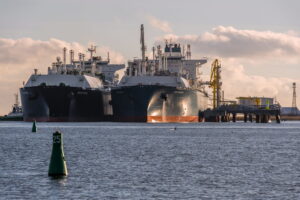An advantageous geographical location and liberalised trade in energy resources allow Australia to successfully compete for the most lucrative and promising liquefied natural gas (LNG) markets. Come 2020, Australia likely will be the world’s largest LNG supplier. However, its domestic LNG industry will have to face the challenge of securing enough natural gas for export. For LNG importers like Poland, the success of those efforts would ensure favourable market conditions – writes Bartosz Wiśniewski from the Polish Institute of International Affairs (PISM)
Australia is the second-largest exporter of LNG, with Qatar topping the list. Australian authorities expect that the volume of LNG exports in 2017 will be as high as 52 million tonnes and Australia’s share of the global market to reach 17%. This would mean a doubling of exports compared with 2014, and is attributable to the launch of four new liquefaction facilities between 2015 and 2017. By 2019, once the existing terminals will have been expanded and two additional ones come on line, Australia’s liquefaction capacity will climb to 88 million tonnes per year (MTPA). At that point, Australia will surpass Qatar, with the U.S. in third place. Natural gas will become Australia’s third most important export commodity, after iron ore and coal.
Assets
Australia’s liquefaction facilities, both in the west and the east, are closer to the largest LNG importers—Japan, South Korea, and China, together accounting for 55% of world demand—than those in Qatar or the U.S. It takes two weeks to ship LNG from the Persian Gulf to Japan. While the expansion of the Panama Canal allowed for increased gas tanker traffic from the U.S., the journey from the Gulf of Mexico to East Asia still takes three weeks. Shipments from Australia need just one week to reach clients in the region. The lower freight costs will remain the backbone of Australia’s competitiveness as an exporter, especially in light of high production costs (Australian LNG plants are the most expensive in the world, costing as much as 50% more than those in the U.S.) and the excess of liquefaction capacity on the market. Even though producers such as Indonesia and Malaysia enjoy an even more favourable position, especially when it comes to supplying the Indian market (7% of global LNG demand), they do not plan any meaningful investment in new liquefaction capacity in the coming years. By 2022, their market share will drop markedly as Australian and U.S. facilities come on line. A facility in Sakhalin, Russia, with a capacity of 10 MTPA, will be in the position to supply a fairly limited share of the market.
The competitiveness of Australian LNG is further enhanced thanks to the elimination of import tariffs by key customers, as well as the application of flexible, affordable, short-term (spot) contracts. As a result, Australia was able to quickly win a sizeable share of the market. A free trade agreement (FTA) with South Korea went into force in December 2014, followed by FTAs with Japan (January 2015) and then with China (December 2015). LNG deliveries to Japan climbed by 25% between 2014 and 2016, with Australia’s market share growing from 20% to 27%. In the case of China, the elimination of trade barriers coincided with the dynamic growth of Chinese demand for LNG: from 13 MTPA in 2011 and 20 MTPA in 2014 to almost 27 MTPA in 2016. Between 2014 and 2016, Australia’s market share surged from 19% to 46%. In that same period, the Qatari share of the Japanese LNG supply market dropped from 18% to 14%, and from 33% to 18% in deliveries to China. Australia moved ahead of Malaysia and Indonesia as a supplier to South Korea. The volume of exports expanded by 5.5 times to reach almost 5 MTPA, making Australia the second-largest supplier to this market with a 14% share (Qatari suppliers keep supplying about 35% of the LNG imports).
Limitations
The most serious challenges have to do with the surge of domestic natural gas prices as a result of increasing volumes of LNG exports, and with the risk of supply shortages for domestic customers. The first phenomenon has already been observed in the eastern and southern parts of the country and is linked to gas transmission infrastructure. These regions house Australia’s largest natural gas consumers (in the power generation sector, petrochemical industry, mining, and largest cities), together amounting to 85% of demand. Three new LNG export facilities were commissioned in eastern Australia in 2015 alone, with a nameplate capacity of 25 MTPA. Between 2015 and 2017, wholesale prices of natural gas increased threefold. Australian authorities reacted by introducing LNG export limits. They will be applied to companies selling the majority of natural gas to foreign customers whenever a shortage of natural gas for domestic customers is forecast. In the longer term, however, Australia will need to invest in the construction of pipelines linking the eastern part of the country to the western and northern regions, which hold more than two-thirds of all its natural gas reserves and which thus far have been focused on developing the capacity to ship it overseas. Infrastructure expansion will be all the more important in light of the likely increase in demand for natural gas. If Australia is to meet the 2015 commitment made in Paris to reduce CO2 emissions by 26–28% by 2030, it will have to limit the share of coal-fired power generation, currently at 63%.
A long-term assessment of the business case for LNG exports is somewhat challenging given the features of natural gas production from coal-bed methane (CBM) deposits. These deposits are the main source of supply for LNG liquefaction terminals in eastern Australia. By 2019, these facilities will represent almost 30% of Australia’s liquefaction capacity. CBM wells can be four times less productive than traditional (conventional) ones. Ensuring sufficient production therefore requires higher outlays for exploration and production. Local authorities expect that supplying 25 MTPA of LNG will require drilling as many as 1,000 new wells a year. Terminals in the west are supplied from off-shore deposits, where production is markedly costlier than onshore deposits.
The availability of resources for these investments will depend on global crude oil prices. Oil indexation still dominates as a pricing formula in long-term LNG contracts for East Asian customers. Spot contracts, while convenient tools for entering the market, do not offer LNG suppliers the sufficiently stable revenue perspective necessary to retrieve the investment made during the construction phase of the export terminals. The costs of Australian liquefaction facilities exceeded the initial expectations and took longer than anticipated to go online. The goal therefore is to ensure the highest possible rate of utilisation of this costly infrastructure.
Outlook
If Australia succeeds in overcoming the challenges facing its LNG industry and secures sufficient supplies of natural has for export, the result will be a strengthening of the most important market trend—the rise of liquefaction capacity exceeds the pace of growth in demand for LNG. Australian natural gas will keep making its way predominantly to East Asia—as much as 90% in 2019. Elsewhere, as in Europe, it will not be competitive vis-à-vis more affordable supplies of both pipeline and liquefied natural gas. Still, European customers will benefit from the greater availability of LNG, especially via spot deliveries. This trend will become even more prominent as the global fleet of LNG tankers grows. By 2022, the number of vessels will rise from the current 440 to 550, with new builds generally boasting larger capacity.
By 2019, natural gas might account for as much as 10% of all Australian exports. The rising prominence of the LNG industry in the Australian economy could translate into growing clout of LNG producers during the formulation of the country’s foreign policy. Together with other energy and mining sectors dependent on East Asian markets, the LNG industry is vitally interested in ensuring freedom and security of navigation, including in the South China Sea. Australia is therefore likely to speak in favour of diplomatic solutions to any territorial disputes in this region. At the same time, China is the largest recipient of Australian exports—32%, twice as much as the second-largest country, Japan, and five times more than South Korea. LNG shipments will only deepen this dependency, even if the majority of natural gas from Australia continues ending up in Japan. As a result, Australia may be reluctant to take a firmer stance in the event of a Chinese-driven escalation in the region, especially if ASEAN countries remain divided on the issue and the U.S. is politically and militarily disengaged.
Source: PISM








